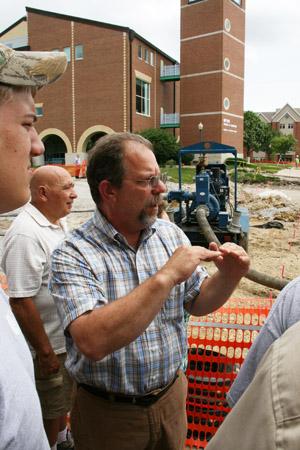
By Anne Marie Amacher
DAVENPORT — A presentation and tour of the extensive storm-water management project underway on St. Ambrose University campus and along busy Locust Street drew about 75 people June 21. The event was sponsored by Partners of Scott County Watershed.
Paul Loete of MSA Professional Services Inc. in Davenport gave the presentation at the Rogalski Center on campus. “This is an exciting and unique project that is getting a lot of attention,” he said. That was evidenced by the crowd in attendance which included St. Ambrose staff, neighbors, media and the curious who wanted to know more.
Loete pointed out that St. Ambrose campus sits in the Duck Creek Tributary Watershed. With more frequent and heavy rainfalls occurring in recent years, flooding in the Cosgrove parking lot on campus and along adjacent Locust Street have been a big concern. The creek has seen some bacteria problems as well. “Perhaps this (project) will help alleviate the problem,” Loete said.
The city of Davenport and St. Ambrose have been working on the flooding issues for more than 10 years, he noted. St. Ambrose has sustained more and more damage to its investments beyond flooding of the parking lot. Retaining walls have collapsed; light fixtures were knocked down; basements and utility rooms have been inundated; and sediment has to be cleaned up. “St. Ambrose wants to protect its investments.”
Loete said the storm-water project’s priorities are eliminating flooding of structures, reducing frequency of flooding in the Cosgrove lot and Locust Street, providing for a safe and effective flow of excess water through campus, and water quality improvement.
To help achieve these goals the project calls for increasing the intake capacity of water at Scott and Ripley streets where they meet Locust Street. This includes replacing 12-inch pipes at those intersections with two 24-inch pipes or one 24-inch and one 30-inch pipe. “This will improve the intake capacity from a six-month rain event to a 10-year rain event.”
Underground detention pipes are being installed under the Cosgrove lot to slowly release water over time — including after rains have ceased. An emergency flow route is being installed through campus with a 54-inch pipe. St. Ambrose has modified some of its utility tunnels so that this part of the project could be completed. And an outdoor storm-water education feature will be added at the end of the project. This will include signage on the Ambrose campus.
During a question-and-answer session, one person asked if the 10-year flood event capacity is enough to prevent flooding. “Yes,” Loete said. The overflow was added to protect the area from a torrential rainfall. But, if the area sustains a 100-year flood event, water will be above ground throughout the campus. “There will be localized flooding, but not near what would happen if this project did not happen.”
“Is this the end of Lake Ambrose?” another person asked. “Yes,” Loete said. People clapped in response.
Another individual asked about maintenance of the new system. Loete said it will be inspected yearly and the intake areas will be cleaned as needed. “It will be trial and error for the university staff to see how often it is needed.”
Jim Hannon, director of physical plant for St. Ambrose, then led the group on a tour of the project as best he could since visitors were not allowed in the work zones. He pointed out the 54-inch pipe area running behind many of the buildings on campus. When that is complete, new sidewalks will be installed.
He explained that the university has been installing retention tanks over the years which can retain 45,000 gallons of water at a time. That water is used for campus cleanup and watering of plants and grass.
The $1.8 million project is being paid for by St. Ambrose, the city of Davenport and a $40,000 Watershed Improvement Review Board grant.
Work began May 16 and is expected to be done on time — Aug. 13.








